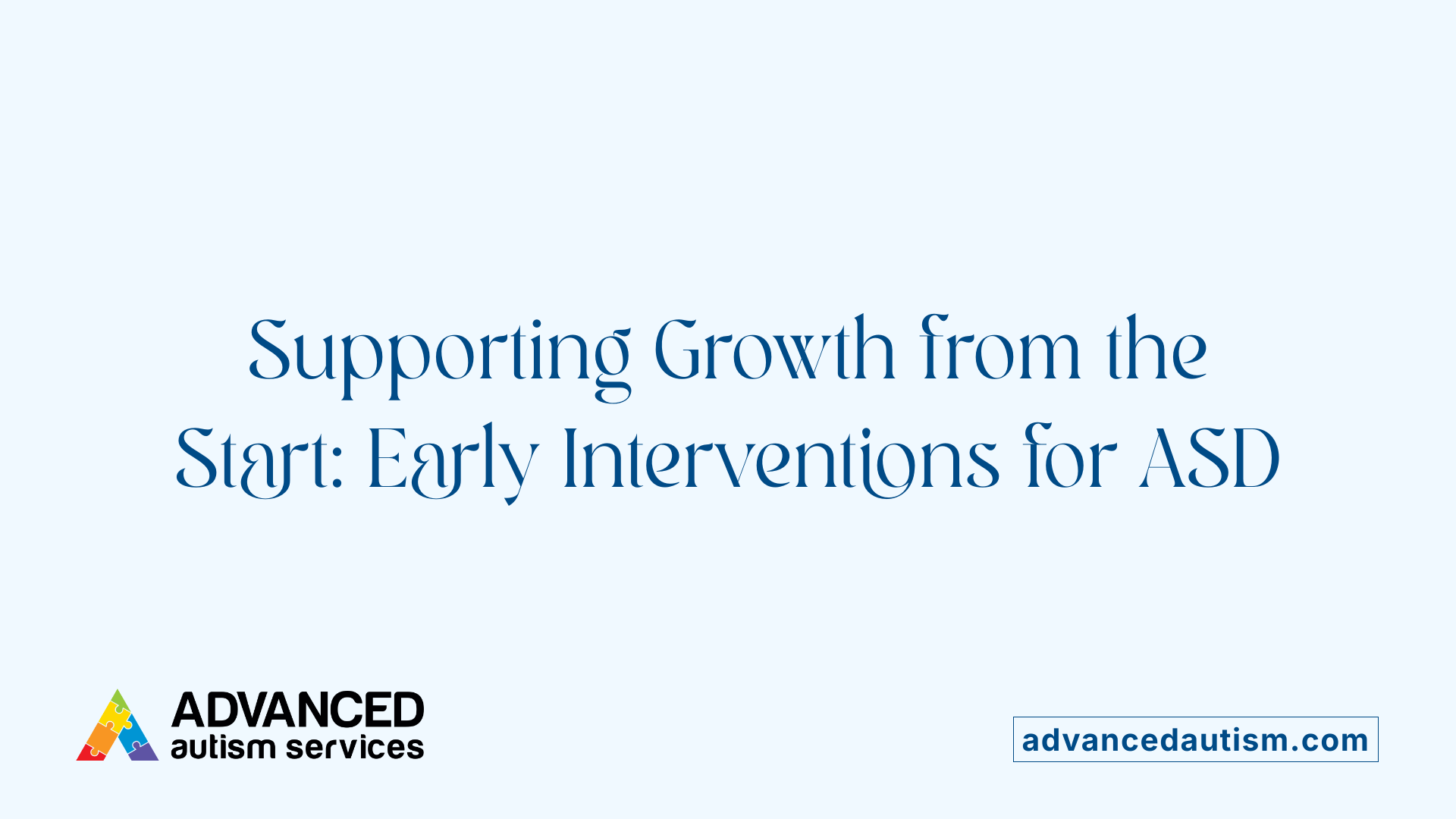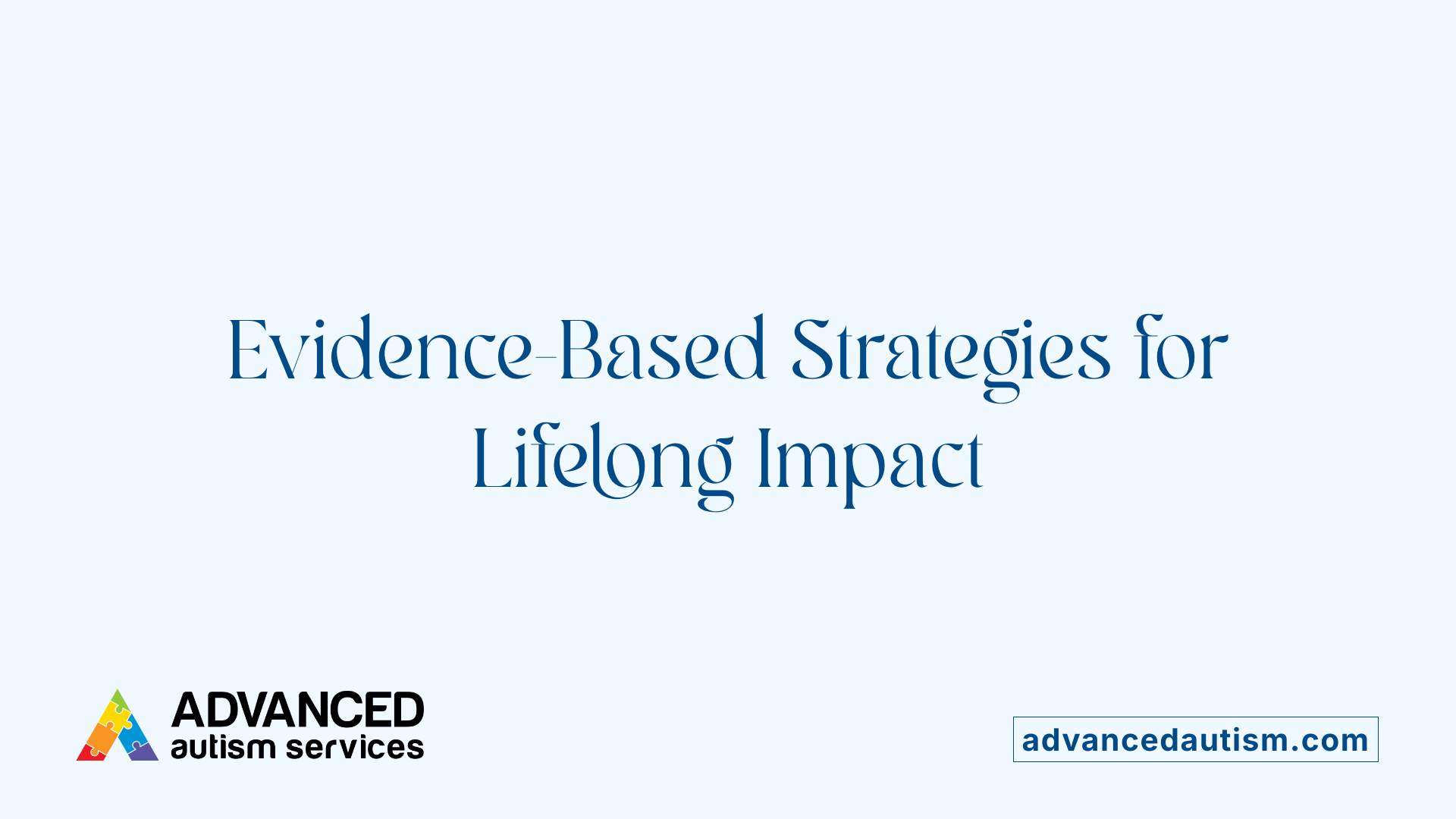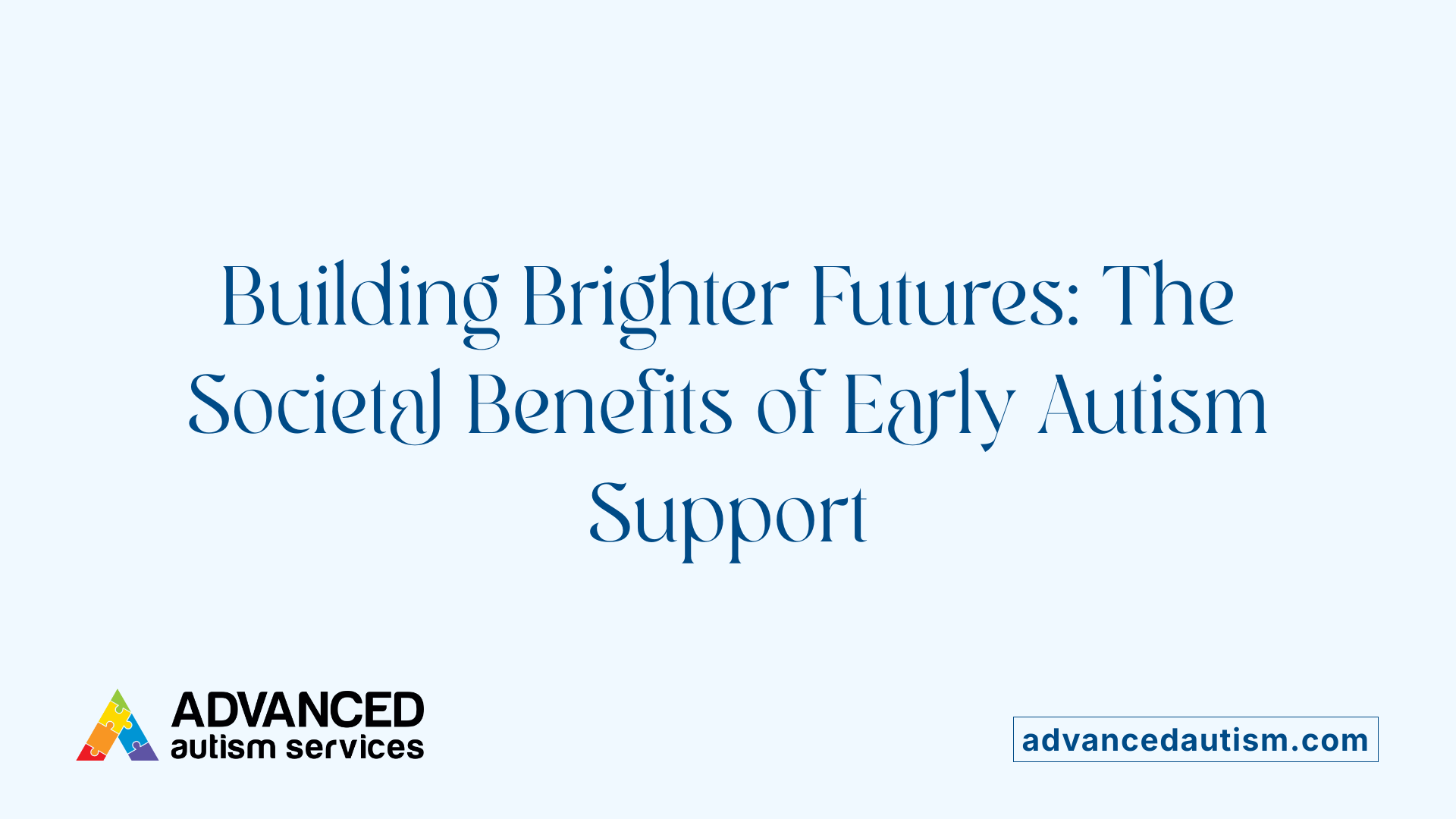Understanding the Critical Role of Early Intervention in Autism Spectrum Disorder
Early intervention for children with autism spectrum disorder (ASD) is a targeted approach that begins as soon as developmental delays or signs of autism are identified, often before age three. The initial years of a child's life are marked by high brain plasticity, making these early stages a window of opportunity for meaningful developmental gains. This article explores the strategies, benefits, and evidence supporting early intervention, emphasizing how timely support can transform outcomes for children with autism and their families.
What is Early Intervention for Autism Spectrum Disorder?

What is early intervention for autism spectrum disorder (ASD)?
Early intervention for autism spectrum disorder (ASD) involves providing specialized services and therapies to young children as early as possible, often before they turn three. The purpose of these programs is to support the development of essential skills such as communication, social interaction, and cognitive abilities.
Services offered during early intervention include speech and language therapy, occupational and physical therapy, behavioral approaches like applied behavior analysis (ABA), and family training. These interventions are designed to be delivered in natural environments like homes or daycare centers, involving both trained professionals and parents.
Starting treatment during the early years leverages the brain's incredible plasticity at this stage. This means the brain can respond more effectively to interventions, leading to better developmental outcomes. Some children have experienced significant improvements, with reductions in core ASD symptoms and even moving off the autism spectrum over time.
Programs like the Early Start Denver Model (ESDM) combine behavioral strategies with relationship-based approaches, demonstrating notable benefits such as increased IQ scores, improved language skills, and better social engagement. Ultimately, early intervention aims to give children with ASD the foundation they need to develop fully, learn vital skills, and increase their independence and quality of life.
Services provided during early intervention
| Service | Description | Purpose |
|---|---|---|
| Speech and Language Therapy | Helps improve communication, including speaking and understanding | Enhance language skills and reduce communication delays |
| Behavioral Therapy (ABA) | Focuses on modifying behaviors and teaching social skills | Reduce problematic behaviors and promote positive interactions |
| Occupational Therapy | Develops skills for daily activities and motor functions | Improve motor skills, sensory processing, and daily functioning |
| Family Training | Educates and involves families in intervention strategies | Empower parents to support their child’s development |
| Physical Therapy | Addresses gross motor development and physical coordination | Enhance physical development and mobility |
Goals of early intervention
- Promote social skills and emotional reciprocity
- Enhance communication capabilities, including non-verbal cues
- Develop cognitive and problem-solving skills
- Improve play and daily living skills
- Reduce challenging behaviors
- Foster independence and support readiness for school
This early support aims to improve long-term outcomes by addressing developmental delays during critical periods of brain growth. With prompt, targeted help, children with ASD can reach their full potential and enjoy a more integrated, independent life.
More information
Searching for "Early intervention programs and therapies for autism" can provide additional resources, research studies, and practical guidance for parents, caregivers, and professionals involved in supporting children with autism.
Key Components and Evidence Supporting Early Intervention

Why is early intervention crucial for children with autism?
Early intervention plays a vital role in supporting children with autism because it takes advantage of a period called brain plasticity. During the first few years of life, a child's brain is especially adaptable, which means that targeted therapies and support can lead to more significant and sustained improvements.
Research indicates that initiating treatment around age 2 or 3 can substantially reduce symptoms of autism, improve communication, social skills, and cognitive development. For example, programs like the Early Start Denver Model (ESDM) have demonstrated that children who begin early intervention exhibit notable gains in IQ, receptive language, and social engagement.
Starting early helps children develop essential skills such as speaking, playing, and interacting with others. It also reduces challenging behaviors and supports emotional and behavioral regulation. These early efforts can prevent future difficulties, making it more likely that children will integrate into society independently.
Furthermore, early intervention supports family well-being by providing resources, education, and strategies to assist their child's development. Children who benefit from prompt support often experience better long-term outcomes, including higher chances of no longer meeting autism diagnosis criteria, improved motor skills, and better overall quality of life.
In summary, the importance of early intervention lies in harnessing the brain's natural developmental window to optimize learning, behavior, and social functioning — setting a foundation for healthier, more adaptive futures.
Effective Types of Therapies and Strategies
What types of therapies are used in early intervention for autism?
Early intervention for autism employs a range of therapies designed to address individual developmental needs. Behavioral approaches, notably Applied Behavior Analysis (ABA), focus on identifying and modifying behaviors through reinforcement, promoting social and language skills. Social skills training programs aim to enhance peer interactions and emotional understanding.
Communication and language therapies, including speech therapy and systems like the Picture Exchange Communication System (PECS), help children develop effective communication methods, crucial for social interaction.
Occupational therapy supports daily living skills, motor development, and sensory integration, assisting children in overcoming sensory sensitivities and improving coordination. Relationship-based strategies, such as parent–child therapies and attachment-focused approaches, foster emotional bonds and social engagement.
Overall, a comprehensive, multidisciplinary approach combines behavioral, communication, sensory, and relational therapies, creating a supportive framework to improve developmental outcomes for children with autism.
How can parents and caregivers support early intervention at home?
Parents and caregivers play a vital role in reinforcing early intervention strategies at home. Actively observing and sharing developmental observations with professionals allows for tailored adjustments to therapy plans. Daily activities like reading stories, playing educational games, and practicing social skills—such as eye contact and turn-taking—can significantly boost language and cognitive development.
Creating a predictable routine and a supportive environment helps children feel secure and encourages learning. Responsive caregiving, characterized by attunement to the child's cues and needs, fosters emotional growth.
Participating in therapy sessions, whether in person or through telehealth options, strengthens the child's progress. Utilizing recommended resources and engaging in recommended exercises boosts development outside of formal sessions.
Furthermore, advocacy and resourcefulness in connecting with community support services empower families to sustain and enhance their child's developmental journey. Such active involvement helps maximize the benefits of early intervention, setting a foundation for lifelong skills and independence.
Long-Term Outcomes and Societal Benefits

What is the impact of early intervention on long-term developmental outcomes for children with autism?
Early intervention plays a crucial role in shaping the future of children with autism. When started at or before preschool age, these programs help improve a child's cognitive, social, communication, and emotional skills. Evidence from recent studies indicates that children who receive early, intensive, and individualized intervention demonstrate significant gains that can continue into adolescence and adulthood.
Research shows that these children often develop higher IQs, better language abilities, and improved motor skills. Some children even experience enough progress to no longer meet diagnostic criteria for autism later in life. Early programs like the Early Start Denver Model (ESDM), delivered in natural environments involving parents and trained therapists, have yielded remarkable results. For example, children in such programs showed an average IQ increase of about 18 points, compared to only four points in children who received standard community-based services.
In addition to cognitive and language improvements, early intervention reduces core autism symptoms, such as repetitive behaviors and social communication difficulties. It also positively influences socio-emotional development, leading to better emotional reciprocity.
What is the likelihood of diagnosis change after early intervention?
One of the most encouraging outcomes of early intervention is that some children diagnosed with autism can experience enough developmental gains to have their diagnosis changed. Studies have documented cases where children improved so markedly that they were reclassified from autism to PDD-NOS (Pervasive Developmental Disorder-Not Otherwise Specified). In one recent study, seven children in an early intervention program experienced such a shift, compared to only one child in the control group. This highlights the potential of early, targeted therapy to alter developmental trajectories.
How does early intervention impact families and society?
Early intervention benefits families by reducing stress, improving understanding of autism, and providing tools to support their child's development. Families involved in programs often receive training that empowers them to carry out therapeutic activities at home, fostering stronger parent-child bonds.
On a societal level, early intervention can lead to substantial savings. Children who receive timely support are more likely to achieve higher levels of independence, participate in mainstream education, and contribute positively to their communities. Long-term, these children tend to require less intensive support, thereby reducing costs for healthcare, education, and social services.
In sum, investing in early, high-quality intervention for children with autism not only enhances their developmental prospects but also provides wider benefits that span families and society at large. These interventions set a foundation for greater societal inclusion, economic productivity, and overall community well-being.
Empowering Children and Families Through Early Action
Recognizing the importance of early intervention in autism spectrum disorder is vital for maximizing developmental potential. From harnessing brain plasticity to providing evidence-based therapies, early intervention offers children the best opportunity to develop essential skills for independence and social participation. For families, early support reduces stress, enhances understanding, and opens pathways to greater involvement in their child's growth. As research continues to validate these approaches, it is clear that prioritizing early detection and intervention is fundamental to fostering brighter futures for children with autism. Through collaborative efforts among healthcare providers, educators, and families, we can ensure that every child receives the support needed to thrive.
References
- Early Intervention for Autism | NICHD
- Study finds autism early intervention highly effective
- Early Intervention - UNC Autism Research Center
- Importance of Early Intervention in Reducing Autistic Symptoms and ...
- Treatment and Intervention for Autism Spectrum Disorder - CDC
- Early Intervention | Autism Speaks
- What Are Early Intervention Strategies for Autism?



